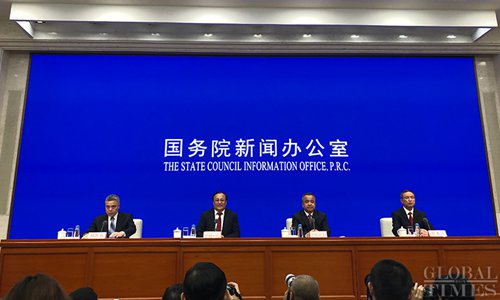
Photo: Liu Xin/GT
Northwest China's Xinjiang Uyghur Autonomous Region has taken a historical leap as regional GDP rose from 791 million yuan in 1952 to 1.22 trillion in 2018, with an average annual growth of 8.3 percent.
The data was released during a press conference held by the State Council Information Office on Tuesday in Beijing to unveil the region's economic and social development.
Several senior officials from Xinjiang, including Shohrat Zakir, deputy secretary of the Communist Party of China (CPC) Xinjiang Committee and chairman of Xinjiang government, Alken Tuniaz, member of the Standing Committee of the CPC Xinjiang Committee and vice-chairman of Xinjiang government, and Zhang Chunlin, member of the Standing Committee of the CPC Xinjiang Committee and executive vice-chairman of Xinjiang government, were present at the press conference.
It may be worthwhile to mention, per capita GDP soared from 166 yuan in 1952 to 49,475 yuan in 2018. The urban per capita disposable income jumped from 319 yuan in 1978 to 32,764 yuan in 2018. The rural per capita net income saw a rise from 119 yuan in 1978 to 11,975 yuan in 2018, a 99.6 times increase.
From 2014 to 2018, 2.31 million people in Xinjiang shook off the shackles of poverty. The incidence of poverty dropped from 19.50 percent overall in Xinjiang and 29.1 percent in southern Xinjiang in 2013 to 6.1 percent and 10.9 percent respectively in 2018.
From 2012 to 2018, Xinjiang created 3.27 million urban jobs, adding 466,900 jobs per year on average, and provided at least one job to each family.
Ethnic unity also made historic progress as the number of ethnic cadres increased from about 3,000 in 1950 to 46,000 in 1955 and 428,000 or 50.3 percent of Xinjiang's cadre headcount in 2018.
An exhibition was also held in the press conference hall alongside the press briefing.

